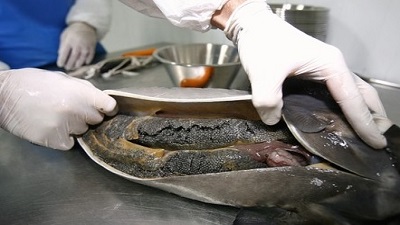0
Taxonomy

The eggs of the beluga sturgeon from the Black Sea. This sturgeon species is listed as threatened under he IUCN Red List of Endangered Species.
- Kingdom: Animalia
- Phylum: Chordata
- Class: Actinoptergii
- Order: Acipenseridae
- Genus: Huso
- Species: Huso huso
Name
- Scientific name: Huso huso.
- Common name: Beluga sturgeon, great sturgeon, giant sturgeon, European sturgeon.
0
Habitat and Distribution
- The Beluga sturgeon is native to the Black, Caspian, Azov and Adriatic Seas.
- Historically they have spawn in the Danube, Dniester, Dnieper and Southern Boug Rivers that flow into the Black Sea; the Volga and Ural Rivers that flow into the Caspian Sea; and the Don River that flows into the Sea of Azov. According to the IUCN Red list of threatened species about 90% of its natural spawning habitat has disappeared.
- Today most populations are supported by hatcheries so its survival depends on them.
- When in marine environments adult beluga sturgeons inhabit shallow waters with muddy bottoms.
Physical Features
- The beluga sturgeon belongs to the oldest group of fishes estimated to be 200 million years old.
- The beluga sturgeon is the largest fresh water fish species of the world. They can reach lengths of up to 19.7 feet or 6 meters and weight up to 2,205 lbs or 1,000 kg. In the past sturgeons of 26.25 feet or 8 meters in length and 7,055 lbs or 3,200 kg in weight have been reported.
- Its back is gray, greenish or black transitioning to white in its underside. Its belly is white and its snout yellow.
- They have strong bony plates called scutes instead of scales.
- Sturgeons have cartilaginous endoskeleton and lack a vertebral centrum.
- They have a shark like tail.
- They have sensory barbells off their elongated snout and have a large crescent shape mouth.
Behavior
- Beluga sturgeons are migrating fish species. They are anadromous, spending part of their lives in saltwater and returning to rivers to spawn.
- During their upriver migration they congregate near the coast prior to entering the rivers. They travel in the deepest parts of the rivers at a depth range of 70 to 180 meters.
- There are two spawning migration peaks. One in the spring from January to April and the other in the fall from August to November.
- Juveniles migrate to the sea in their first summer and remain there until they reach maturity.
Reproduction
- Female beluga sturgeons reach reproductive maturity between 19 and 22 years old, while males between 14 and 16.
- Females can carry from 230,000 to 1 million eggs depending on their size.
- Females will spawn every 3 to 4 years and will keep her eggs until condition is suitable.
- They spawn far upstream the river during high water levels and strong currents at a water temperature of 48.2° to 62.6° F or 9° to 17° C.
- Eggs are laid on the gravel or rocky bottoms of the river bed.
- Hatchings swim towards the sea and remain in warm shallow waters.
- The beluga sturgeon does not provide care for their offspring.
Diet
- Beluga sturgeons eat fresh water and marine fish, baby seals, carp, herring, crayfish, gobies and pike perch.
- Juveniles eat insect larvae and start to prey on fish when they are 9.4 in or 24 cm in length.
Life Expectancy
- They can live in excess of 100 years.
Beluga Caviar
- Beluga caviar is the unfertilized roe or eggs of the Beluga sturgeon.
- A female beluga sturgeon can produce 12% of its body weight in caviar.
- It is the most expensive caviar and the most expensive food item in the world. It sells for $3,500/lbs or $8,000/kg.
- In the United States since 2005 the importation of Beluga caviar and products made from it is prohibited under the U.S. Endangered Species Act.
Threats
- The beluga sturgeon is a predatory fish, there are no known predators other than humans.
- Due to the development and construction of hydropower dams, irrigation channels and dykes that alter the water flow in rivers, the beluga sturgeon’s spawning habitat range has been reduced and the reproduction of this species has suffered the greatest impact.
- Overfishing for meat and caviar.
- There is a decrease in the size of beluga sturgeons today due to overfishing of large species which yield larger roe.
- The majority of beluga sturgeons do not die of natural causes, most get caught before they reach maturity.
- Because of its slow reproduction maturity and low population numbers scientists estimate that its recovery will take more than 100 years.
Conservation Status
- The beluga sturgeon is highly vulnerable to extinction in its entire range.
- Currently most populations in their natural habitat are supported by hatcheries. Their survival depends on stocking.
- The IUCN Red List of Endanger Species lists the beluga sturgeon as “critically endangered”.
- International trade is restricted under CITES II.
- It is protected under Appendix III of the Bern Convention.
Did you know?
- The most expensive beluga caviar is “Almas” sold for $34,500 for 2lbs 3oz or 1kg. Almas is produced from the eggs of the rare albino beluga sturgeon from the southern Caspian Sea in Iran.
Resources and further research
University of Michigan Museum of Zoology – Huso huso Beluga
Science Daily – Beluga sturgeon threatened with extinction
Institute for Ocean Conservation Science – Sturgeons of the Caspian Sea and Ural River
